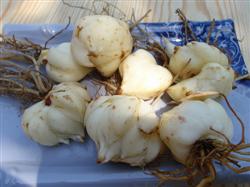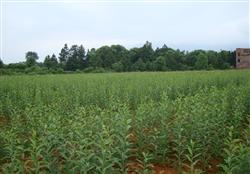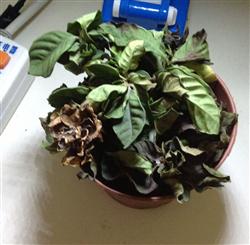How to grow edible lilies?

How to grow edible lilies? How to fertilize lilies and control diseases and insect pests? Please give guidance to edible lily cultivation can refer to the following methods: 1. Land preparation: we should choose sandy soil with fertile soil, high terrain, good drainage and loose soil. 2. Combined with soil preparation, 2000 kg of organic fertilizer per mu plus 40-50 kg of Yangfeng compound fertilizer was used as base fertilizer. 50-60 kg of lime (or 50% 0.6Kg) was applied per mu for soil disinfection. Then fine rake flat to make a width of 1.3m each or flat border, the border ditch width 30cm, around a deeper drainage ditch, good drainage. 2. The main planting method is bulb propagation. The bulbs with tight clasping scales, white shape, no damage and no diseases and insect pests were selected as species. The seed stem was soaked in 70% methyl topiramate, or carbendazim or agricultural streptomycin solution for 15-30 minutes for disinfection, dried and seeded. The appropriate time is from late September to October. On the finished border, the horizontal trench is opened according to the row spacing 25cm, the deep ditch 12cm, and then, every 15cm (plant spacing) is placed into a small bulb, the top is up, covered with fine soil, covered with soil, a layer of fallen leaves or straw is added to prevent and moisturize, gently press the leaves and grass, and remove them when sprouting. There are 1-15000 plants per mu and 150,200 / kg per mu. 3. Field management (1) Prophase management. In winter, select sunny days for ploughing, drying topsoil, preserving soil moisture and heat preservation. Loosen the soil and weed before spring emergence, increase the ground temperature, promote the early development of seedlings, and cover the grass to preserve soil moisture. Summer should prevent the rot caused by high temperature; keep cool and keep warm, prevent frost, and apply seedling fertilizer to promote the growth of lilies. (2) mid-and late-stage management. One is to clear ditches and drain water. Second, hit the top at the right time. The best time is when the bud changes from upright to drooping, and the color changes from all-green to pink on the sunny side. The time is June. The third is to control the application of nitrogen fertilizer after topping. To promote the rapid hypertrophy of young bulbs. Before and after the Summer Solstice, the bulbs should be removed and the soil moisture in the ditch should be cleaned in time to reduce the temperature and humidity in the field. (3) topdressing. The first time was to apply wax fertilizer steadily. When the lily seedlings were not unearthed in January, urea was applied about 5-10 kg per mu to promote the emergence of new roots. The second time is to re-apply strong seedling fertilizer, when lily seedlings are 10-20cm high in the first ten days of April, Yangfeng compound fertilizer 10-15 kg per mu plus urea 5-10 kg per mu to promote strong seedlings. The third time is suitable for bulb expansion fertilizer, in the first and middle of June, after flowering and topping, Yangfeng 48% urea-based compound fertilizer 30-40 kg per mu was applied to promote bulb hypertrophy. At the same time, 0.2% potassium dihydrogen phosphate was sprayed on the leaves. The topdressing should be completed 40-50 days before mining. 4. Pest control (1) Lily blight is one of the common diseases of lily, which occurs heavily in rainy years, causing stem and leaf rot to seriously affect the yield of bulbs. The pathogen can invade stems, leaves, flowers and scales. After the base of the stem was killed, the water-stained constriction occurred, which led to the rapid withering and death of the whole plant. Leaf disease, disease spot water stains, light brown, showing irregular large spots. When the disease is serious, flowers, pedicels and scales can be killed, resulting in discoloration and corruption. Control methods: ① implements rotation; ② selects land cultivation with good drainage and loose soil; ③ seed ball disinfection; ④ strengthens field management and pays attention to ditch drainage; phosphorus and potassium fertilizer is applied to make seedlings grow strong; ⑤ sprays 1 ∶ 2 ∶ 200 Bordeaux solution once before emergence, spray 50% carbendazim 800 times solution 2 times 3 times after emergence to protect seedlings; remove diseased plants in time after disease and treat them with 50% quicklime. (2) the damaged plants showed yellow leaves or yellow spots, yellow spots, acute defoliation, poor plant growth and atrophy. The buds are yellow and can not open, and in severe cases, the plants wither and die. Control methods: ① breeding disease-resistant varieties or disease-free bulb propagation; ② to strengthen field management, appropriate application of phosphorus fertilizer and potassium fertilizer to make plants grow strong and enhance disease resistance; ③ pulled out seriously damaged plants to control aphids as early as possible to reduce the re-infection of infected aphids. (3) Leaf blight and soft rot are the main diseases in the growing season and during storage, respectively. Control methods: select robust, disease-free bulbs to breed, soak the seeds with 50% benzimidazole 500 Mel 600 times solution for 30 minutes before sowing, and sow the seeds after drying. Do not touch the bulb as much as possible during harvest and shipment, and pay attention to ventilation and cooling during storage. (4) the common insect pests are aphids, beetle larvae and mites. Aphids harm, often clustered in the tender leaves and buds to absorb juice, so that the plant atrophy, poor growth, flowering and fruiting are affected. Control methods: ① clean the countryside, eradicate weeds in the field, reduce the overwintering insect population; spray 2000 times of permethrin, or 1500 times of omethoate, or 1000 times of malathion during the occurrence of ②. Beetle larvae can use malathion and zinc parathion. Mites can be used as acaricides. Click to get more lily planting techniques click to get more flower planting techniques
- Prev

What diseases do you need to control when planting dragon bud lily?
What diseases do you need to control when planting dragon bud lily? Please introduce the diseases that need to be controlled in planting lily: leaf blight: if yellow brown and reddish brown oval spots appear on the leaves, 1000 times of methyl thiophane WP, 50% of hydantoin WP 1500 times solution, or 50% of speed g...
- Next

Why are gardenia leaves withering?
Why are gardenia leaves withering? Please introduce the causes and control methods of gardenia leaf wilting is mainly caused by the high ph value in the soil, it is recommended to use humus-rich loam cultivation. Watering flowers with water had better be sleepy and then add an appropriate amount of vinegar to make it slightly acidic, the specific ph can be used p.
Related
- Fuxing push coffee new agricultural production and marketing class: lack of small-scale processing plants
- Jujube rice field leisure farm deep ploughing Yilan for five years to create a space for organic food and play
- Nongyu Farm-A trial of organic papaya for brave women with advanced technology
- Four points for attention in the prevention and control of diseases and insect pests of edible fungi
- How to add nutrient solution to Edible Fungi
- Is there any good way to control edible fungus mites?
- Open Inoculation Technology of Edible Fungi
- Is there any clever way to use fertilizer for edible fungus in winter?
- What agents are used to kill the pathogens of edible fungi in the mushroom shed?
- Rapid drying of Edible Fungi

